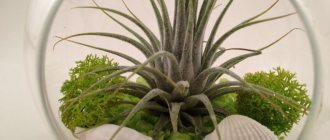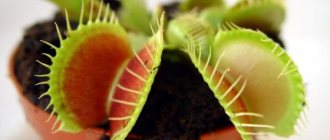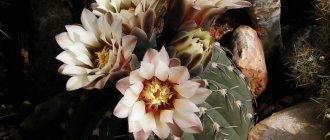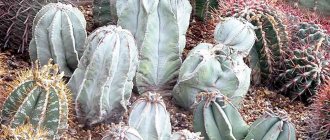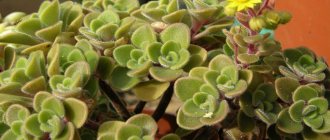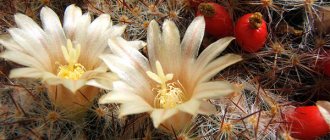Many people associate cacti with the desert, hot sun, rocky terrain and constant drought, which leads to a large number of mistakes in caring for these plants. In addition, each individual species has its own characteristics and requires certain maintenance conditions. In fact, everything is not so complicated, and any cactus can become a real decoration for your home if, before purchasing, you study the types of these indoor plants and find out what climate and conditions are typical for the homeland of this or that cactus.
Distribution and species
The word "cactus" was used by the scientist Carl Linnaeus, which was short for melocactus. Melocacti are all plants with thorns and sharp needles. There are many types and varieties.
The most common:
- Opuntia - has very sharp needles. Reaches 30 cm in height.
- Mammillaria is popular because it is easy to care for. It is strewn with numerous “soft” thorns. Mammillaria has a large number of “papillae” from which flower buds bloom.
- Rebutia is a mountain cactus. The stem has a spherical shape, is completely covered with thorns, and blooms in spring. The flowers of this species are large. Unlike others, it does not tolerate dry soil well.
- Cereus - at home it can grow up to half a meter. This species does not tolerate direct sunlight, and without a cold winter it will not bloom.
- Echinopsis is a very popular indoor cactus. Hardy plant, suitable for beginners.
- Echinocactus is a very large species, grows slowly at home and usually does not bloom.
- Echinocerius is very light-loving; flowers can grow to sizes larger than the plant itself.
- Coryphanta - spherical or cylindrical in shape, blooms in summer.
- Frailea - have a small spherical stem, flowers are huge compared to the stem. In winter, the optimal temperature is +12 degrees and a minimum of watering, but in summer watering must be increased.
- Wilcoxia is an unremarkable plant until it blooms. At the beginning of spring it is covered with large flowers. Proper cultivation requires plenty of light and fresh air.
- Christmas tree - blooms in winter, which requires abundant watering. Does not like direct sunlight, so diffused light is needed.
- Cleistocactus Strauss - covered with an abundance of spines and white hairs, the height can reach one meter. A fairly sun-loving plant, but at midday it is better to shade it a little.
- Lophophora cactus - the juice of this cactus has a medicinal effect when used in small quantities. In the central part there is an areola, from which many hairs emerge, uniting into a thick tuft.
- Lubivia - was named after Bolivia, where the cactus is native. The young plant has a spherical stem shape, but over time it stretches. The stem is weakly branched, many children are formed on it. Thanks to this, large cushion-shaped formations - colonies - grow on one stem.
These popular specimens grow both in the wild and on gardeners' windowsills.
How to determine the age of a cactus?
If you read the information about a cactus, its age is determined not by years, but by wintering or dormant periods.
If, for example, for 3 years the cactus grew in the same conditions: at the same air temperature, humidity, lighting - then all 3 calendar years are counted as one year of the plant’s life.
Wintering for cacti most often occurs when the temperature is below 18-20 degrees. At this temperature, the life processes of the cactus freeze, and at this time it does not require watering or care. As the air temperature rises, the cactus begins to come to life and this time is considered the beginning of a new year in the life of the plant.
Plant classification
Succulents come in different types. They can be divided into four groups:
- Pereskiaceae with full leaves are something between a thorn and deciduous plants.
- Opuntiaceae have reduced leaves and very fragile spines.
- Mauchienivae are found in Patagonia. Outwardly, they are very similar to prickly pear.
- Cacti are the most common. Most of the common succulents belong to this group. Their stem has a spherical or cylindrical shape and beautiful flowers.
These groups can also be divided into 9 subgroups:
- Deciduous.
- Leaf-shaped.
- Elongated or candle-shaped.
- Multi-stemmed.
- Ball-shaped.
- Hemorrhoids.
- Papillary.
- Coraloides.
- Palm-shaped.
Each subgroup has its own characteristics both in appearance and in terms of content.
Geographical distribution: from desert to windowsill
Today, many prickly creatures have taken root well on different continents. Prickly pear, for example, has acclimatized remarkably well in Spain, France, Italy, India and even Australia.
It can be found in Crimea, especially often in the territory of Sudak. Some varieties also tolerate the harsh conditions of the Astrakhan region, where temperatures can drop to -12 degrees.
The homeland of the indoor cactus is on the American continent, but its distribution there is uneven. For example, in Mexico, Argentina, Bolivia, and Chile, this creature is represented by great diversity, but the Amazon basin and Central America are practically not inhabited by it. Prickly pears grow well even in Canada, in British Columbia, but in other areas of the New World it is difficult to find. The furthest climbed was the southern pterocactus, which grows near the Strait of Magellan, that is, at the very extreme point of South America.
Classification of spiny inhabitants
Cacti flowers can be classified into four large groups:
- Pereskiaceae with full leaves. They are considered a transitional link between ordinary cacti and types of deciduous plants;
- Opuntiaceae are distinguished by reduced leaves and special, very fragile spines that have serrated serrations;
- Mauchienivae are found only in Patagonia. Outwardly, it is almost an analogue of prickly pear, but they do not have glochidia. These small cacti have leaves only 10 mm long;
- Cacti are considered the most common. It is to this family that most of the true cacti that we are so accustomed to belong to. They have a cylindrical or spherical shape, beautiful flowers on a tube. This includes epiphytic, creeping, columnar and other varieties.
Beneficial features
What could be the benefit of cacti, these rather prickly inhabitants that have long and firmly established themselves on our window sills, and, more recently, on our computers? The plant is interesting because it is used in many areas of life. But the information that it protects from harmful electromagnetic radiation is a myth, although it is useful for the eyes to take a break from an overly bright screen on the green surface of a pet that grows in a pot next to the computer.
If you familiarize yourself with the history of many peoples, you can see that the properties of the cactus are varied, which makes it possible to use it for a variety of purposes. Many species can be eaten (not only the leaves themselves, but also flowers and roots). The plant is still used as animal feed.
Cereus, for example, is used as a building material from which fences are made. Moreover, today such green fences reliably protect even the elite mansions of the local rich in Mexico. The dried wood itself, that is, a completely dehydrated trunk, acquires high strength with low weight. This material is used as rafters, beams, and support pillars in the construction of small private houses.
The composition of the cactus allows the plant to be used for the production of a wide variety of alcoholic and non-alcoholic drinks that differ in their characteristic taste. From some species you can even obtain technical alcohol.
The plant is used in the production of shampoos, vitamins, hormonal preparations, and deodorants. Varieties such as prickly pear, which are easy to grow at home, are great for preparing incredibly tasty dishes. The pulp, fruits and flowers can be stewed, made into jam, compotes and jellies. And species such as echinocactus and melocactus can be candied.
Some varieties can be used as natural antibiotics. Houseplants that are so often grown in kindergartens must include cacti in their list, since kids can take care of them themselves.
What do we know about “green hedgehogs”?
Today, more than two thousand different species are known. They all differ in size, shape, and growing conditions. They have different flowering periods, and some do not bloom at all. So what do we know about these spiny inhabitants today?
A cactus can be not only round or flat, but completely covered with strong, sharp spines. Most pets are not impressive in size, although among them there are very attractive, unusual shapes. In nature, species such as Opuntia or Caldera can take the form of a large ear or a giant candelabra, reaching a height of up to 20 m. And Rebutia grows only a couple of centimeters. Some varieties resemble a starfish or a beer keg, while there are varieties that resemble a coiled snake or even a wrinkled human face.
- The root system is powerful, even in the smallest representatives. It spreads not only in depth, but even in breadth. This allows the plant to receive the required nutrients. The cactus flower also deserves attention. These representatives do not bloom as rarely as is believed; you just need to follow the rules of care. The flowers themselves are distinguished by a variety of shades; in some cases, the size of the buds even exceeds the size of the plant itself. Their fragrance is also unusual: some buds bloom and fade within just one day. In some varieties, they open only at sunset, so that at dawn, when ordinary flowers “wake up,” they close their petals.
- Home cacti, which grow in dry areas, can save the lives of lost travelers. The fact is that this particular plant is a natural reservoir for water. It is preserved in a pure, drinkable form, but as a very thick syrup. At home, it is easy to notice that the plant does not have enough moisture - it begins to wrinkle, like a baked apple.
Large cacti, which have sharp and strong needles, are used by many wild tribes to heal serious wounds. The needles are carefully removed from the surface and then sterilized using charcoal. Then they are used for high-quality suturing; they are used to tighten the edges of the wound.
The cactus is an amazing plant, a real storehouse of mysteries. This is the only specimen that can survive severe drought, although it still prefers abundant moisture and not too high temperatures. These little “green hedgehogs”, which so often live on our windowsills, grow into entire colonies in nature. Many of their types have beneficial properties, some varieties can be eaten.
Homeland of cacti: where did these amazing representatives of the flora come from?
There is a widespread belief that the homeland of the cactus is a desert, in which for many kilometers there is nothing but sand and wandering camels. Indeed, these inhospitable, thorny plants are primarily associated with desert landscapes. And they came to us from the hot African continent, and in addition, these succulents are able to exist in rocky, lifeless soils, withstanding the scorching sun. However, they are not originally from the Sahara, Gobi or Kalahara. Their habitat is somewhat different, but today it has expanded so much that members of the family are found almost all over the world. What country can boast of being the real homeland of this unusual plant - the cactus?
About the homeland of succulents and their distribution
Today, these cacti grow on any continent where climatic conditions suitable for them are present. But even where the climate is unsuitable, they are successfully grown in greenhouses and as indoor flowers.
This is interesting! As for the first historical mentions of the country of origin of cacti, back in the second half of the 16th century, the German scientist, “father of botany” Jacob Theodor Tabernemontanus published his own herbal book, which gained enormous popularity. In it, he described some varieties of these succulents, which were native to the shores of South America.
So it turns out that cacti became known outside the country of origin no earlier than the discovery of America by Christopher Columbus. And South America is recognized as the birthplace of the indoor cactus. It was from here that these plants began to spread throughout the planet, taking root even where the climate differs from the usual. Some varieties were first discovered in North America, as well as on the islands of the West Indies.
Rhipsalis baccifera grows not only in America, but also in Africa, Madagascar and Sri Lanka. They got here without human help, because it is believed that the seeds of these plants were carried by migratory birds.
But the most beautiful prickly pear, consisting of flat palm-shaped leaves, can be found in India, the Mediterranean countries, Germany, Austria, Mozambique, on the islands of the Malay Archipelago and even in Australia, thanks to the intervention of human hands. The prickly pear species Opuntia humifusa grows far from its native shores, and not only in the Mediterranean, but also on the shores of Crimea, in the southern regions of the Volga region, on the Russian Black Sea coast, in the regions of Gelendzhik and Novorossiysk.
And although their homeland is in a different place, cacti feel at home almost everywhere, including on home windowsills. Especially if they receive proper care based on their needs.
Interesting Facts
- The medieval navigator Christopher Columbus in his notes says that the indigenous people of America he met ate melon. In fact, the Indians ate cactus.
- Cacti serve as raw materials for the production of alcoholic beverages, cosmetics, food products, including confectionery, medicines, soaps and much more.
- The tiniest cacti in the world are called Blossfeldia, whose maximum height is only 1-3 centimeters.
- The largest cacti in the world are Californian cereus, whose age can reach 150 years and height - 20 meters.
- Scientists have proven that the spines of the plant have the property of ionizing the air.
- In ancient times, plant needles were successfully used for medicinal purposes, for example, to stitch up deep wounds.
- Some plant species feed on insects. Thanks to their specific aroma, they attract small insects and then eat them.
- Cows that eat the thorny plant produce more milk.
Mexico and cacti
There are not many places on Earth where the weather is as warm in winter as in summer, and Mexico is one of them. Maybe that’s why a great variety of cacti grow here, about 1000 species - spherical, cushion-shaped, columnar, tree-shaped, compact and very large. It’s not for nothing that Mexico is nicknamed “the land of cacti.”
These plants have become so deeply ingrained in the lives of local residents that it is almost impossible to separate concepts such as Mexico and cacti. The modern capital of the state, Mexico City, is located on the site of the ancient Aztec city of Tenochtitlan, whose name translates as “place of the sacred prickly pear.”
This is interesting! The largest number of these succulents grows on the territory of the Baja California peninsula; it is not for nothing that it is nicknamed the “planetary garden of the desert.” Its shores are washed by the Pacific Ocean and separated from the mainland by the Gulf of California. Of the more than a hundred species of cacti growing here, 80 of them are endemic and cannot be found anywhere else on the planet.
In general, it is difficult to imagine the landscape of this country without these plants, because most often, with some exceptions, it consists of mountains, desert spaces and... cacti. At the end of the 5-6 month drought, the desert will be transformed, it will turn green, and some of the cacti will bloom luxuriously. Some of them attract attention more than others:
It is impossible not to notice the huge candelabra cacti, the height of which can exceed three meters. If you look closely, you can see small white flowers on them.
Cactus: the birthplace of the plant
Cacti are perennial flowering plants belonging to the Carnation family. The concept itself comes from the Greek word "kaktos", which was used to refer to unknown herbs and plants.
The term "cactus" was first used in 1737 by scientist Carl Linnaeus as a shortened form of melocactus. The last term included all plants with thorns and sharp needles. The cactus (the plant’s homeland is North and South America) is a real “storehouse” of water and grows in various climatic conditions.
The first mentions of cacti
Before botany became a systematic science, many plants were mistakenly considered related. Various succulents were called cacti (from the Latin succulentus - “succulent”), and varieties that did not have thorns were classified as a different species. At the end of the 16th century. Flemish scientists presented a reliable image of one of the melon cacti. Following them, the botanist Carl Linnaeus first used the term Cactus (ancient Greek κάκτος - “thistle”) in relation to this plant, which gave the name to the whole family.
The cactus came to Europe after its first travels to the New World and soon became a popular exhibit in private botanical collections. Some pieces were worth twice as much in gold equivalent as they weighed.
History of origin and etymology
The history of the emergence of thorny plants is still shrouded in mystery. Scientists cannot find reliable facts based solely on logical assumptions. A feature of the etymology is the absence of remains of ancient cacti that were not preserved as fossils. Even Aztec bas-reliefs and rock paintings depicted plants similar to modern varieties of cacti: melocactus, prickly pear and cereus. This similarity indicates that during the process of their evolution they did not undergo major changes.
According to scientists, the cactus has existed for more than 50 million years. The plant is native to the arid regions of North and South America. Over the course of many millennia, they adapted to the peculiarities of climatic conditions and formed external characteristics. There are no recorded analogues of these amazing plants in the plant world, which are capable of vegetating for 2 years using their own moisture reserves.
Particularly difficult is the period of adaptation of cacti in desert conditions, since the level of humidity in such an area is minimal. To reduce the consumption of their own moisture, plants are overgrown with a durable leathery shell. During the process of photosynthesis, they produce cell sap, which has a slimy structure. This viscous liquid helps plants maintain water balance and eliminates their need for additional oxygen.
Routes to Russia
After Columbus's first voyage around the world, active exploration of the lands of the New World began. In addition to spices, hunting trophies and luxury goods, little-studied plant species, including cacti, began to arrive in Europe.
With the development of apothecary business under Peter I, exotic succulents began to be imported to Russia.
Doctors invited from Europe were by that time aware of the medicinal properties of aloe and used it in their practice. Following these plants, prickly pears and euphorbias entered the Apothecary Garden established by the emperor by the middle of the 18th century. From the records of the Medical Chancellery it is known that some of them were sold to private individuals.
In subsequent centuries, cacti were also imported by Russian travelers exploring the lands of South America. Thus, the Russian ethnographer G. Langsdorff and botanist L. Riedel, who traveled through the Amazon, transported several thousand living specimens to their homeland.
Basic rules of care
Before you start growing or collecting cacti, you need to carefully study the information about the rules for caring for them. In general, care comes down to watering, correct temperature, grafting and replanting.
Selection of capacity
First of all, you need to choose the right container. The plant's homeland has given the cactus a rather capricious nature, so the size of the pot must clearly correspond to its root system. In order to correctly determine the size of the required container, remove the sprout from the container, straighten its roots and inspect their branching. In some cacti, the root system is more developed in the upper part, so the root length is short. For such sprouts it is better to choose wide and shallow pots.
Those varieties of cactus whose roots grow long require a deep pot. When choosing a container, also consider the nature of plant propagation. Species such as mammillaria (the largest variety) form a large number of “babies”, so many small plants appear in the pot. In these cases, it is necessary to use wide pots.
Attention! You should not use metal containers, as rust can have a detrimental effect on the cactus.
.
Soil selection
Preparing the land for replanting a cactus is a responsible and important process. The choice of soil is influenced by many factors, such as the type of cactus, the homeland of the plant, and its age. There are several recipes for preparing soil, but the constant ingredients remain leaf, clay-turf, old greenhouse soil, humus, coarse river sand, charcoal and brick chips. The soil for the plant is chosen based on your experience and preferences, but the main condition remains the looseness of the soil and its acidity of no more than 4.5-6.
Ideal soil composition for indoor cactus
In order for the plant to produce flowers on time and not lose its attractive appearance, you need to choose the right components for the soil. The soil should allow moisture and air to pass through and give a slightly acidic reaction (not higher than 6.5 on the Ph scale). The soil must contain small pebbles, brick chips or coarse sand to provide drainage at the roots, otherwise putrefactive processes will begin.
A small amount of peat and greenhouse substrate will give the plant the necessary nutrition, rich in microelements.
The composition of the soil in which the cactus will grow properly must be balanced in each case differently:
- Ariocarpus, Astrophytum, Lophophora and other desert specimens require twice as much turf soil as leaf soil.
- Large cereus cacti need humus, which is added in a ratio of 1:4 to the amount of peat.
- Adult cacti should grow in denser soil, the main part should be greenhouse soil and clay-turf soil.
- Cacti with long spines need calcium supplements. Finely crushed eggshells will do.
Coal will prevent the roots from rotting, but it should be remembered that it alkalizes the soil. The admixture of clay in the soil blocks the excessive release of moisture from it.
You should not add too much humus or nitrogenous fertilizers - most cacti do not need growth stimulation.

